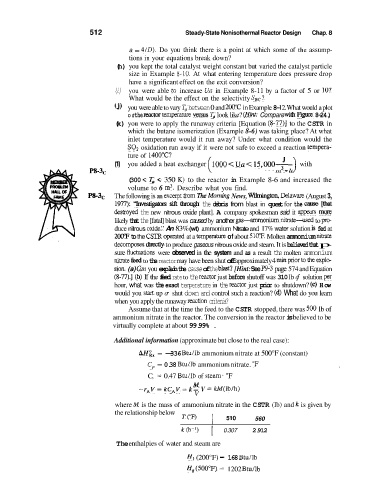Page 542 - Elements of Chemical Reaction Engineering Ebook
P. 542
512 Steady-State Nonisothermal Reactor Design Chap. 8
a = 410). Do you think there is a point at which some of the assump-
tions in your equations break down?
(h) you kept the total catalyst weight constant but varied the catalyst particle
size in Example 8-10, At what entering temperature does pressure drop
have a significant effect on the exit conversion?
(i) you were able to increase Ua in Example 8-11 by a factor of 5 or lo?
What would be the effect on the selectivity SBc?
( j) you were able to vary T, between 0 and 200°C in Example 8- 12. What would a plot
Of the te- vetsus T, look like? (H&; Compare with Elgune 8-24.)
(k) you were to apply the runaway criteria [Equation (8-77)J to the CSTR in
which the butane isomerization (Example 8-6) was taking place? At what
inlet temperature would it run away? Under what condition would the
SO2 oxidation run away if it were not safe to exceed a reaction tempera-
ture of 14OO0C?
(
(1) you added a heat exchanger 1000 < Ua < 15, OOOT oh with
(300 < T, < 350 K) to the reactor in Example 8-6 and increased the
m J ,
volume to 6 m3. Describe what you find.
The following is an excerpt frmn 7h Morning News, Whnhgton, Delawsre (August 3,
1977): 'TnvestigatOls sift thmgh the debris from blast in quest for the awe [hat
destroyed the new nitrous oxide plant]. A company spokesman said it appears WE
likely that the [fatal] blast was caused by another gas-ammoniun nitrate-used to p
duce nitrous oxide." An 83% (wt) ammonium Ntrate and 17% water solution is fed at
2009; to the CSTR opxated at a ternpame of about 510% Molten ammonium Nme
decomposes M y to produce gaseous nitrous oxide and steam. It is believed that p-
sure fluctuations were observed in the system and as a result the molten ammonium
nime feed to the reactor may have been shut off approximately 4 min priortotheexplc~
sion. (a) Can you explain the cause of the blast? [Hint: See B-3 page 574 and Equation
(8-n).] (b) If the feed rate to the reactar just before shutoff was 310 lb of solution per
hour, what was the exact temperature in the reactar just prior to shutdown? (c) How
would you start up or shut down and control such a reaction? (d) What do you learn
when you apply the runaway don criteria?
Assume that at the time the feed to the CSTR stopped, there was 500 lb of
ammonium nitrate in the reactor. The conversion in the reactor is believed to be
virtually complete at about 99.99%.
Additional information (approximate but close to the real case):
AH& = -336 Btu/lb ammonium nitrate at 500°F (constant)
C, = 0.38 Btu/lb ammonium nitrate. "F
C, = 0.47 Btu/lb of steam. "F
M
V
-rAV = KC,V = k - kM(lb/h)
V
where M is the mass of ammonium nitrate in the CSTR (lb) and k is given by
the relationship below
T ("E) I 510 560
k (h-'1 I 0.307 2.912
I
The enthalpies of water and steam are
Hi (200°F) = 168 Btu/lb
H,(500"F) 1202 Btu/lb
==

